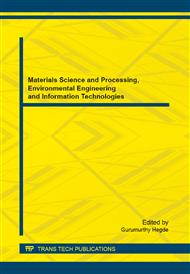[1]
A. K. Alva, Possible utilization of fuel-gas desulfurization gypsum and fly ash for citrus production: Evaluation of crop growth response. Waste Management. 1994; 14(7): 621-627.
DOI: 10.1016/0956-053x(94)90034-5
Google Scholar
[2]
S. Sahu, S. A. Brown, and R. J. Lee, Thaumasite formation in stabilized coal combustion by-products. Cement and Concrete Composites. 2002; 24(3-4): 385-391.
DOI: 10.1016/s0958-9465(01)00091-9
Google Scholar
[3]
K. A. Galos, T. S. Smakowski, and J. Szlugaj, Flue-gas desulphurisation products from Polish coal-fired power-plants. Applied Energy. 2003; 75(3-4): 257-265.
DOI: 10.1016/s0306-2619(03)00039-4
Google Scholar
[4]
X. L. Guo and H. S. Shi, Thermal treatment and utilization of flue gas desulphurization gypsum as an admixture in cement and concrete. Construction and Building Materials. 2008; 22(7): 1471-1476.
DOI: 10.1016/j.conbuildmat.2007.04.001
Google Scholar
[5]
S. Kumar, R. Kumar, A. Bandopadhyay, et al., Mechanical activation of granulated blast furnace slag and its effect on the properties and structure of portland slag cement. Cement and Concrete Composites. 2008; 30(8): 679-685.
DOI: 10.1016/j.cemconcomp.2008.05.005
Google Scholar
[6]
H. Binici, O. Aksogan, I. H. Cagatay, et al., The effect of particle size distribution on the properties of blended cements incorporating GGBFS and natural pozzolan (NP). Powder Technology. 2007; 177(3): 140-147.
DOI: 10.1016/j.powtec.2007.03.033
Google Scholar
[7]
H. Binici, H. Temiz, and M. M. Ke, The effect of fineness on the properties of the blended cements incorporating ground granulated blast furnace slag and ground basaltic pumice. Construction and Building Materials. 2007; 21(5): 1122-1128.
DOI: 10.1016/j.conbuildmat.2005.11.005
Google Scholar
[8]
K. O. Davidsson, J. G. Korsgren, J. B. C. Pettersson, et al., The effects of fuel washing techniques on alkali release from biomass. Fuel. 2002; 81(2): 137.
DOI: 10.1016/s0016-2361(01)00132-6
Google Scholar
[9]
F. -Q. Zhao, W. Ni, H. -J. Wang, et al., Activated fly ash/slag blended cement. Resources, Conservation and Recycling. 2007; 52(2): 303-313.
DOI: 10.1016/j.resconrec.2007.04.002
Google Scholar
[10]
L. Ren-Ping, G. Bin, R. Ailing, et al. Studies on characteristics of Semi-dry FGD ash from iron industry. 2009. Piscataway, NJ, USA: IEEE.
Google Scholar


